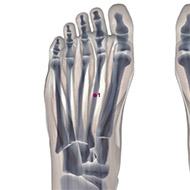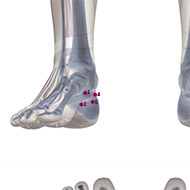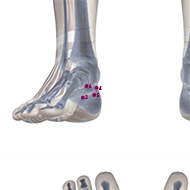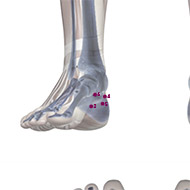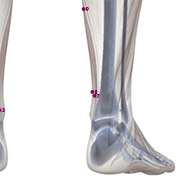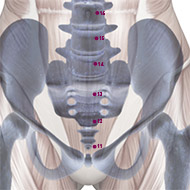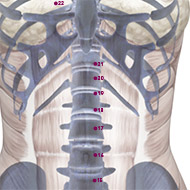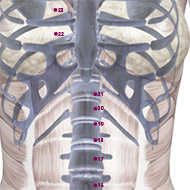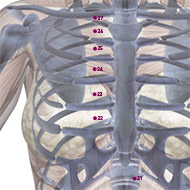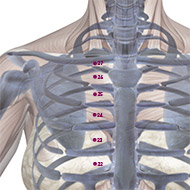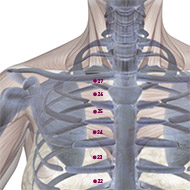The meridian system (simplified Chinese: 经络; traditional Chinese: 經絡; pinyin: jīngluò, also called channel network) is a concept in Traditional Chinese medicine (TCM) about a path through which the life-energy known as “qi” flows.1 The twelve standard meridians, also called principal meridians, are divided into Yin and Yang groups. The Yin meridians of the arm are Lung, Heart, and Pericardium. The Yang meridians of the arm are Large Intestine, Small Intestine, and Triple Burner. The Yin Meridians of the leg are Spleen, Kidney, and Liver. The Yang meridians of the leg are Stomach, Bladder, and Gall Bladder.2 The Kidney Meridian or Kidney Channel is one of the 12 principal meridians in TCM. It corresponds with the Taiyang Bladder Meridian of the Foot. The Flow Hours of this meridian are 5:00 PM – 7:00 PM.3
CONTENTS
ORGAN AND FUNCTION
ACUPOINTS
FLOWING ROUTES
ORGAN AND FUNCTION
According to Traditional Chinese Medicine (TCM), the kidney (腎: Shèn) refers to either of the two viscera located on the small of the back, one either side of the spine. As distinct from the Western medical definition of kidneys, the TCM concept is more a way of describing a set of interrelated parts than an anatomical organ. In TCM the kidneys are associated with “the gate of Vitality”. The kidney is the organ of water and fire, the abode of yin and yang, the sea of essence, and it determines life and death.4
The kidney (Shen) is a Zang organ meaning it is a Yin organ. The other Yin, or Zang, organs are the lungs (Fei), liver (Gan), spleen (Pi), and heart (Xin). Sometimes the pericardium (Xin Bao) is included. Yin organs store, secrete, make, and transform essence, blood, spirit, Qi, and fluids.5 The Kidney meridian has the following principal functions:
-It stores the essence (jing) and it dominates human reproduction and development.
-It dominates bone, water metabolism and the reception of qi from the air (Kong Qi).
-It produces marrow to fill up the brain and manufactures blood.
-It manifests in the hair (on the head), and it opens into the ear and dominates the two lower yin.
-It dominates the anterior and posterior orifices while housing the Zhi (will-power).
-Its fluid secretions are urine, semen, and vaginal fluids. 6
ACUPOINTS
This meridian contains 27 acupoints in one side, that is 54 acupoints in total.
KD-1
Location: On the sole, in the depression when the foot is in plantar flexion, approximately at the junction of the anterior one-third and posterior two-thirds of the line connecting the base of the 2nd and 3rd toes and the heel.
Indications: Headache, blurring of vision, dizziness, sore throat, dryness of the tongue, loss of voice, dysuria, infantile, convulsions, feverish sensation in the sole, loss of consciousness.
Method: Puncture perpendicularly 0.3-0.5 inch. Moxibustion is applicable.
Vasculature: Deeper, the plantar arterial arch.
Innervation: The second common plantar digital nerve.
KD-2
Location: Anterior and inferior to the medial malleolus, in the depression on the lower border of the tuberosity of the navicular bone.
Indications: Pruritus vulvae, prolapse of uterus, irregular menstruation, nocturnal emission, hemoptysis, thirst, diarrhea, swelling and pain of the dorsum of foot, acute infantile omphalitis.
Method: Puncture perpendicularly 0.3-0.5 inch. Moxibustion is applicable.
Vasculature: The branches of the medial plantar and medial tarsal arteries.
Innervation: The terminal branch of the medial crural cutaneous nerve, the medial plantar nerve.
KD-3
Location: In the depression between the tip of the medial malleolus and Achilles’ tendon.
Indications: Sore throat, toothache, deafness, tinnitus, dizziness, spitting of blood, asthma, thirst, irregular menstruation, insomnia, nocturnal emission, impotence, frequency of micturition, pain in the lower back.
Method: Puncture perpendicularly 0.3-0.5 inch. Moxibustion is applicable.
Vasculature: Anteriorly, the posterior tibial artery and vein.
Ihnervation: The medial crural cutaneous nerve, on the course of the tibial nerve.
KD-4
Location: Posterior and inferior to the medial malleolus, in the depression anterior to the medial side of the attachment of Achilles’ tendon.
Indications: Spitting of blood, asthma, stiffness and pain of the lower back, dysuria, constipation, pain in the heel, dementia.
Method: Puncture perpendicularly 0.3-0.5 inch. Moxibustion is applicable.
Vasculature: The medial calcaneal branch of the posterior tibial artery.
Innervation: The medial crural cutaneous nerve, on the course of the medial calcaneal ramus derived from the tibial nerve.
KD-5
Location: 1 cun directly below Taixi (KD-3) in the depression of the medial side of the tuberosity of the calcaneum.
Indications: Amenorrhea, irregular menstruation, dysmenorrhea, prolapse of uterus, dysuria, blurring of vision.
Method: Puncture perpendicularly 0.3-0.5 inch. Moxibustion is applicable.
Regional anatomy: See Dazhong (KD-4).
KD-6
Location: In the depression below the tip of the medial malleolus.
Indications: Irregular menstruation, morbid leukorrhea, prolapse of uterus, pruritus vulvae, frequency of micturition, retention of urine, constipation, epilepsy, insomnia, sore throat, asthma.
Method: Puncture perpendicularly 0.3-0.5 inch. Moxibustion is applicable.
Vasculature: Posteriorly, the posterior tibial artery and vein.
Innervation: The medial crural cutaneous nerve; deeper, the tibial nerve.
KD-7
Location: 2 cun directly above Taixi (KD-3), on the anterior border of Achilles’ tendon.
Indications: Edema, abdominal distension, diarrhea, borborygmus, muscular atrophy of the leg, night sweating, spontaneous sweating, febrile diseases without sweating.
Method: Puncture perpendicularly 0.5-0.7 inch. Moxibustion is applicable.
Vasculature: Deeper, anteriorly, the posterior tibial artery and vein.
Innervation: The medial sural and medial crural cutaneous nerves; deeper, the tibial nerve.
KD-8
Location: 0.5 cun anterior to Fuliu (KD-7), 2 cun above Taixi (KD-3) posterior to the medial border of tibia.
Indications: Irregular menstruation, dysmenorrhea, uterine bleeding, prolapse of uterus, diarrhea, constipation, pain and swelling of testis.
Method: Puncture perpendicularly 0.5-0.7 inch. Moxibustion is applicable.
Vasculature: Deeper, the posterior tibial artery and vein.
Innervation: The medial crural cutaneous nerve; deeper, the tibial nerve.
KD-9
Location: 5 cun directly above Taixi (KD-3) at the lower end of the belly of m. gastrocnemius, on the line drawn from Taixi (KD-3) to Yingu (KD-10).
Indications: Mental disorders, pain in the foot and lower leg, hernia.
Method: Puncture perpendicularly 0.5-0.7 inch. Moxibustion is applicable.
Vasculature: Deeper, the posterior tibial artery and vein.
Innervation: The medial sural and medial crural cutaneous nerves, deeper, the tibial nerve.
KD-10
Location: When the knee is flexed, the point is on the medial side of the popliteal fossa, between the tendons of m. semitendinosus and semimembranosus, at the level with Weizhong (BL-40).
Indications: Impotence, hernia, uterine bleeding, dysuria, pain in the knee and popliteal fossa, mental disorders.
Method: Puncture perpendicularly 0.8-1.0 inch. Moxibustion is applicable.
Vasculature: The medial superior genicular artery and vein.
Innervation: The medial femoral cutaneous nerve.
KD-11
Location: 5 cun below the umbilicus, on the superior border of symphysis pubis, 0.5 cun lateral to Qugu (CV-2).
Indications: Fullness and pain of the lower abdomen, dysuria enuresis, nocturnal emission, impotence, pain of genitalia.
Method: Puncture perpendicularly 0.5-1.0 inch. Moxibustion is applicable.
Vasculature: The inferior epigastric artery and external pudendal artery.
Innervation: The branch of the iliohypogastric nerve.
KD-12
Location: 4 cun below the umbilicus, 0.5 cun lateral to Zhongji (CV-3).
Indications: Nocturnal emission, impotence, morbid leukorrhea, pain in the external genitalia, prolapse of uterus.
Method: Puncture perpendicularly 0.5-1.0 inch. Moxibustion is applicable.
Vasculature: The muscular branches of the inferior epigastric artery and vein.
Innervation: The branches of subcostal nerve and the iliohypogastric nerve.
KD-13
Location: 3 cun below the umbilicus, 0.5 cun lateral to Guanyuan (CV-4).
Indications: Irregular menstruation, dysmenorrhea, dysuria, abdominal pain, diarrhea.
Method: Puncture perpendicularly 0.5-1.0 inch. Moxibustion is applicable.
Vasculature: See Dahe (KD-12).
Innervation: The subcostal nerve.
KD-14
Location: 2 cun below the umbilicus, 0.5 cun lateral to Shimen (CV-5).
Indications: Abdominal pain and distension, diarrhea, nocturnal emission, irregular menstruation, dysmenorrhea, postpartum abdominal pain.
Method: Puncture perpendicularly 0.5-1.0 inch. Moxibustion is applicable.
Vasculature: See Dahe (KD-12)
Innervation: The eleventh intercostal nerve.
KD-15
Location: 1 cun below the umbilicus, 0.5 cun lateral to Yinjiao (CV-7).
Indications: Irregular menstruation, abdominal pain, constipation.
Method: Puncture perpendicularly 0.5-1.0 inch. Moxibustion is applicable.
Vasculature: see Oahe (KD-12).
Innervation: The tenth intercostal nerve.
KD-16
Location: 0.5 cun lateral to the umbilicus, level with Shenque (CV-8).
Indications: Abdominal pain and distension, vomiting, constipation, diarrhea.
Method: Puncture perpendicularly 0.5-1.0 inch. Moxibustion is applicable.
Vasculature; See Dahe (KD-12)
Innervation: The tenth intercostal nerve.
KD-17
Location: 2 cun above the umbilicus, 0.5 cun lateral to Xiawan (CV-10).
Indications: Abdominal pain, diarrhea, constipation.
Method: Puncture perpendicularly 0.5-1.0 inch. Moxibustion is applicable.
Vasculature: The branches of the superior and inferior epigastric arteries and vems.
Innervation: The ninth intercostal nerve.
KD-18
Location: 3 cun above the umbilicus, 0.5 cun lateral to Jianli (CV-11).
Indications : Vomiting, abdominal pain, constipation, postpartum abdominal pain, sterility.
Method: Puncture perpendicularly 0.5-1.0 inch. Moxibustion is applicable.
Regional anatomy Vasculature: The branches of the superior epigastric artery and vein.
Innervation: The eighth intercostal nerve.
KD-19
Location: 4 cun above the umbilicus, 0.5 cun lateral to Zhongwan (CV-12).
Indications: Borborygmus, abdominal pain, epigastric pain, constipation, vomiting.
Method: Puncture perpendicularly 0.5-1.0 inch. Moxibustion is applicable.
Regional anatomy: See Shiguan (KD-18).
KD-20
Location: 5 cun above the umbilicus, 0.5 cun lateral to Shangwan (CV-13).
Indications: Abdominal pain and distension, vomiting, indigestion.
Method: Puncture perpendicularly 0.5-1.0 inch. Moxibustion is applicable.
Regional anatomy: See Shlguan (KD-18).
KD-21
Location: 6 cun above the umbilicus, 0.5 cun lateral to Juque (CV-14).
Indications: Abdominal pain and distension, indigestion, vomiting, diarrhea, nausea, morning sickness..
Method: Puncture perpendicularly 0.3-0.7 inch. To avoid injuring the liver, deep insertion is not advisable. Moxibustion is applicable.
Regional anatomy Vasculature: See Shiguan (KD-18).
Innervation: The seventh intercostal nerve.
KD-22
Location: In the fifth intercostal space, 2 cun lateral to the Conception Vessel.
Indications: Cough, asthma, distension and fullness in the chest and hypochondriac region vomiting, anorexia.
Method: Puncture obliquely 0.3-0.5 inch. To avoid injuring the heart, deep insertion is not advisable. Moxibustion is applicable.
Vasculature: The fifth intercostal artery and vein.
Innervation: The anterior cutaneous branch of the fifth intercostal nerve; deeper, the fifth intercostal nerve.
KD-23
Location: .In the fourth intercostal space, 2 cun lateral to the anterior midline.
Indications: Cough, asthma, fullness in the chest and hypochondriac region, mastitis.
Method: Puncture obliquely 0.3-0.5 inch. Moxibustion is applicable.
Vasculature: The fourth intercostal artery and vein.
Innervation: The anterior cutaneous branch of the fourth intercostal nerve; deeper, the fourth intercostal nerve.
KD-24
Location: In the third intercostal space, 2 cun lateral to the anterior midline.
Indications: Cough, asthma, fullness in the chest and hypochondriac region, mastitis.
Method: Puncture obliquely 0.3-0.5 inch. Moxibustion is applicable.
Vasculature: The third intercostal artery and vein.
Innervation: The anterior cutaneous branch of the third intercostal nerve; deeper, the third intercostal nerve.
KD-25
Location: In the second intercostal space, 2 cun lateral to the anterior midline.
Indications: Cough, asthma, chest pain.
Method: Puncture obliquely 0.3-0.5 inch. Moxibustion is applicable.
Vasculature: The second intercostal artery and vein.
Innervation: The anterior cutaneous branch of the second intercostal nerve; deeper, the second intercostal nerve.
KD-26
Location: In the first intercostal space, 2 cun lateral to the anterior midline.
Indications: Cough, asthma, accumulation of phlegm, fullness in the chest and hypochondriac region.
Method: Puncture obliquely 0.3-0.5 inch. Moxibustion is applicable.
Vasculature: The first intercostal artery and vein.
Innervation: The anterior cutaneous branch of the first intercostal nerve, the medial supraclavicular nerve; the first intercostal nerve.
KD-27
Location: In the depression on the lower border of the clavicle, 2 cun lateral to the anterior midline.
Indications: Cough, asthma, chest pain.
Method: Puncture obliquely 0.3-0.5 inch. Moxibustion is applicable.
Vasculature: The anterior perforating branches of the internal mammary artery and vein.
Innervation: The medial supraclavicular nerve.
FLOWING ROUTES
This meridian originates from the plantar surface of the little toe and runs obliquely towards the center of the sole (Yongquan, KD-1). Then, it emerges from the lower aspect of the tuberosity of the navicular bone (Rangu, KD-2), it runs behind the medial malleolus where one of its branches enters the heel. Then, it ascends along the posterior border of the medial side of the lower leg to the medial side of the popliteal fossa and goes further upwards along the posteromedial aspect of the thigh to the coccygeal region (Changqiang, GV-1). From there, it runs through the vertebral column, enters the kidney and links with the urinary bladder.
The straight branch emerging from the kidney ascends through the liver and diaphragm and enters the lung. From there, it travels along the throat and terminates at the root of the tongue. The branch emerging from the thigh root runs alongside the perineum to the lower abdomen. Then, it goes upwards along the region 0.5 cun lateral to the abdominal midline to the subclavian region (Shufu, KD-27). The branch stemming from the lung joins the heart and runs into the chest to meet with jueyin pericardium meridian of the hand.7
Footnotes
- What Is Traditional Chinese Medicine – sciencebasedmedicine.org – 2012, https://sciencebasedmedicine.org/what-is-traditional-chinese-medicine/
- Advanced Pressure Point Fighting of Ryukyu Kempo – A Dillman Karate International Book – 1994, https://www.amazon.com/Advanced-Pressure-Point-Fighting-Ryukyu/dp/0963199633/
- Acupuncture points of the Kidney meridian of the hand – cnacupuncture.com – 2017, http://www.cnacupuncture.com/points-of-the-kidney-meridian-of-foot-shaoyin.html
- The foundations of chinese medicine: a comprehensive text for acupuncturists and herbalists – Black Dog & Elsevier Churchill Livingstone – 2005, https://www.amazon.com/Foundations-Chinese-Medicine-Comprehensive-Acupuncturists/dp/0443074895
- Chinese natural cures – Black Dog & Leventhal Publishing – 1994, https://www.abebooks.com/book-search/isbn/1579120563/
- Chinese acupuncture and moxibustion – Foreign Languages Press – 1987, https://www.amazon.com/Chinese-Acupuncture-Moxibustion-Seventeenth-Printing/dp/7119059947/ref=sr_1_1?s=books&ie=UTF8&qid=1493125663&sr=1-1
- Shaoyin Kidney Meridian of the Foot – tcmwiki.com – 2017, https://tcmwiki.com/wiki/shaoyin-kidney-meridian-of-foot
LU01
LU02
LU03
LU04
LU05
LU06
LU07
LU08
LU09
LU10
LU11
LI01
LI02
LI03
LI04
LI05
LI06
LI07
LI08
LI09
LI10
LI11
LI12
LI13
LI14
LI15
LI16
LI17
LI18
LI19
LI20
ST01
ST02
ST03
ST04
ST05
ST06
ST07
ST08
ST09
ST10
ST11
ST12
ST13
ST14
ST15
ST16
ST17
ST18
ST19
ST20
ST21
ST22
ST23
ST24
ST25
ST26
ST27
ST28
ST29
ST30
ST31
ST32
ST33
ST34
ST35
ST36
ST37
ST38
ST39
ST40
ST41
ST42
ST43
ST44
ST45
SP01
SP02
SP03
SP04
SP05
SP06
SP07
SP08
SP09
SP10
SP11
SP12
SP13
SP14
SP15
SP16
SP17
SP18
SP19
SP20
SP21
HT01
HT02
HT03
HT04
HT05
HT06
HT07
HT08
HT09
SI01
SI02
SI03
SI04
SI05
SI06
SI07
SI08
SI09
SI10
SI11
SI12
SI13
SI14
SI15
SI16
SI17
SI18
SI19
BL01
BL02
BL03
BL04
BL05
BL06
BL07
BL08
BL09
BL10
BL11
BL12
BL13
BL14
BL15
BL16
BL17
BL18
BL19
BL20
BL21
BL22
BL23
BL24
BL25
BL26
BL27
BL28
BL29
BL30
BL31
BL32
BL33
BL34
BL35
BL36
BL37
BL38
BL39
BL40
BL41
BL42
BL43
BL44
BL45
BL46
BL47
BL48
BL49
BL50
BL51
BL52
BL53
BL54
BL55
BL56
BL57
BL58
BL59
BL60
BL61
BL62
BL63
BL64
BL65
BL66
BL67
KD01
KD02
KD03
KD04
KD05
KD06
KD07
KD08
KD09
KD10
KD11
KD12
KD13
KD14
KD15
KD16
KD17
KD18
KD19
KD20
KD21
KD22
KD23
KD24
KD25
KD26
KD27
PC01
PC02
PC03
PC04
PC05
PC06
PC07
PC08
PC09
TB01
TB02
TB03
TB04
TB05
TB06
TB07
TB08
TB09
TB10
TB11
TB12
TB13
TB14
TB15
TB16
TB17
TB18
TB19
TB20
TB21
TB22
TB23
GB01
GB02
GB03
GB04
GB05
GB06
GB07
GB08
GB09
GB10
GB11
GB12
GB13
GB14
GB15
GB16
GB17
GB18
GB19
GB20
GB21
GB22
GB23
GB24
GB25
GB26
GB27
GB28
GB29
GB30
GB31
GB32
GB33
GB34
GB35
GB36
GB37
GB38
GB39
GB40
GB41
GB42
GB43
GB44
LV01
LV02
LV03
LV04
LV05
LV06
LV07
LV08
LV09
LV10
LV11
LV12
LV13
LV14
GV01
GV02
GV03
GV04
GV05
GV06
GV07
GV08
GV09
GV10
GV11
GV12
GV13
GV14
GV15
GV16
GV17
GV18
GV19
GV20
GV21
GV22
GV23
GV24
GV25
GV26
GV27
GV28
CV01
CV02
CV03
CV04
CV05
CV06
CV07
CV08
CV09
CV10
CV11
CV12
CV13
CV14
CV15
CV16
CV17
CV18
CV19
CV20
CV21
CV22
CV23
CV24



